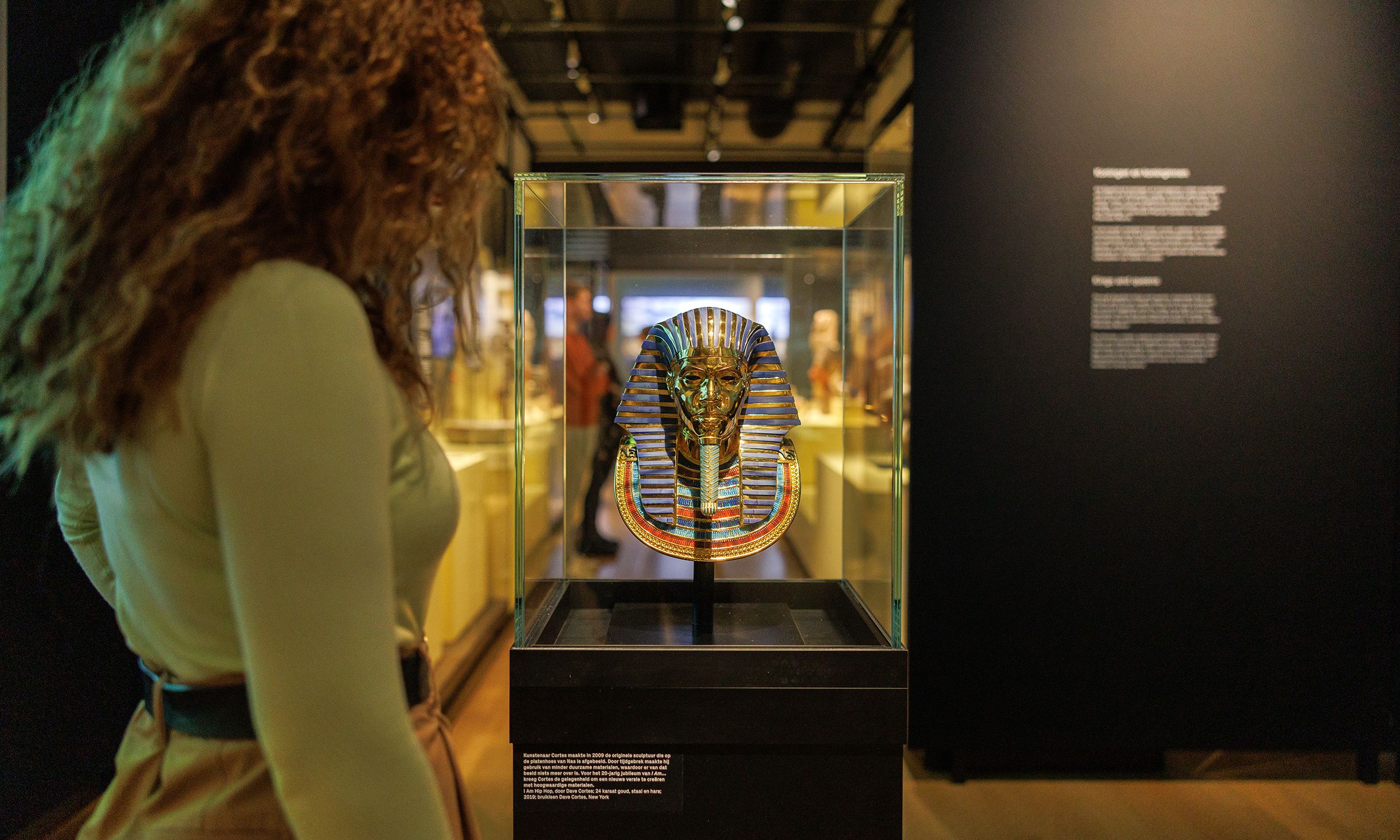David Cortes, I Am Hip Hop (2019) Photo: National Museum of Antiquities, Leiden
A Dutch museum has provoked social media anger that has spread as far as Egypt with an exhibition on how ancient Egyptian culture has been seen through the eyes of artists with African roots.
The National Museum of Antiquities in Leiden, the Netherlands, opened the show Kemet: Egypt in hip hop, jazz, soul & funk (until 3 September), to link its collection with black artists’ explorations of ancient Africa—from notions of spirituality, pride and power to eye make-up and costume.
But it has unintentionally provoked ire including, according to the Egypt Independent newspaper, questions to government from a member of Egypt’s House of Representatives for alleged cultural appropriation and showing artwork representing a Black man as an ancient Egyptian.
A vistor to the exhibition Kemet: Egypt in hip-hop, jazz, soul & funk © Photo: National Museum of Antiquities, Leiden
The exhibition runs coincidentally at the same time as a Netflix show that has stirred up international controversy by portraying Cleopatra as Black. In recent weeks, after outraged comment on Facebook group Egyptian History Defenders, the Dutch museum saw an influx of one-star Google reviews with comments like “Egypt was never Black”, briefly suspended its Facebook page and issued a defence.
Dr Daniel Soliman, the curator of the Egyptian and Nubian collection, who is half-Egyptian, says they were aware that the topic would be sensitive but that the show was displaying points of view that have often been neglected by the museum world.
“This is a very difficult topic and that is the thing with this exhibition: I think you really have to give it a chance,” he says. “There are several voices in the exhibition, and maybe some of that nuance is difficult to communicate through a single Facebook post, for example. There are Egyptians, or Egyptians in the diaspora, who believe that the pharaonic heritage is exclusively their own. The topic of the imagination of ancient Egypt in music, predominantly from the African diaspora, Black artists in different styles, jazz, soul, funk, hip-hop, had long been ignored.”
With the help of music, video, interviews and colourful artefacts, the exhibition compares its own pieces such as a wall relief from 640BC with the way that ancient Egypt has inspired Black artists including Erykah Badu, Beyoncé, Rihanna and John Singleton, the maker of Michael Jackson’s Remember The Time video.
It represents debates around cultural appropriation, looting, nose shape in ancient Egyptian statues and most controversially shows a golden, Tutankhamun-like statue by David Cortes, titled I Am Hip Hop. The statue, on loan from the artist, is based on a 1999 Nas album cover portraying the black rapper as an Egyptian statue. This has led to reported criticism from some Egyptian antiquities experts such as Abd al-Rahim Rihan that the museum was “portraying Tutankhamun as Black”—something it denies.
Record cover of Nas' album I Am… © Columbia Records, 1999
Dr Soliman stresses the show does not take a standpoint beyond giving space in a museum for a different set of viewpoints. “I think ancient Egypt oftentimes is presented either through images created in academia or in popular culture or art as being rather monolithic,” he says. “There will have been people who, nowadays, we would have called in Western terminology Black people. That doesn’t mean that we can put that label on an entire culture that lasted for 3,000 years. But that’s something that is difficult to maybe explain to people, especially if certain stereotypes have been perpetuated.”
Wim Weijland, the director of the National Museum of Antiquities, says in a statement the museum does not claim all ancient Egyptians were Black. “The exhibition does not have an Afrocentric perspective on ancient Egypt, but critically talks about some ideas presented in the music,” he explains. “For example, the exhibition explains that the word Kemet refers to the black fertile soil along the Nile, not to skin colour [and] that there is no truth to the conspiracy theory that the noses of statues were cut off in modern times to hide presumed African features.”
The museum says it welcomes all perspectives. “It's very important that Egyptians in Egypt and Egyptians in the diaspora are included in talks about ancient Egypt, because it's undeniable how they feel a connection,” says Dr Soliman. “And in fact, we've always tried to do this.”

